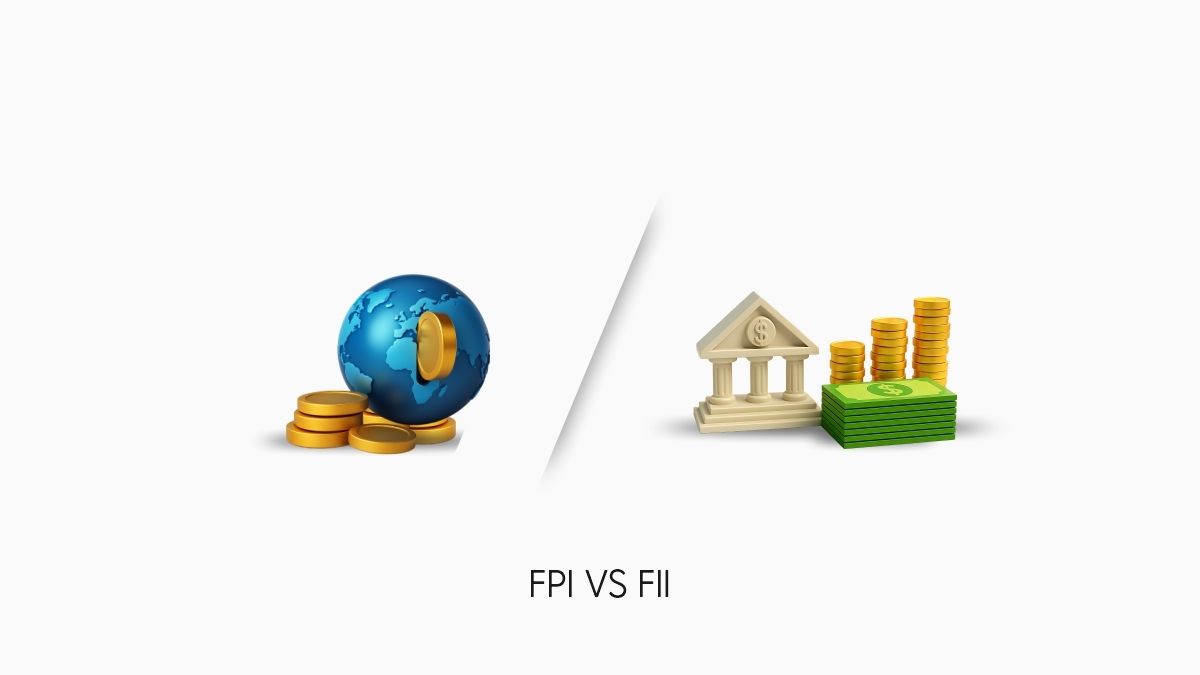FPI Vs FII: Key Difference Between FPI And FII

- Published Date: July 03, 2025
- Updated Date: July 17, 2025
- By Team Choice
In today’s global economy, emerging markets like India attract significant interest from international investors. Foreign Portfolio Investment (FPI) and Foreign Institutional Investment (FII) represent the two dominant pathways for foreign capital into India's financial markets. Although these terms are often used interchangeably, they carry distinct meanings under current regulatory frameworks.
This article will explore the FPI vs FII differences, essential for policymakers and individual investors who want to understand how global investment trends impact the Indian market.
FPI: Meaning & Features
Foreign Portfolio Investment (FPI) describes the financial inflows from foreign individuals, institutions, or entities into a country's stock and bond markets, as well as other marketable securities. Crucially, FPI differs from Foreign Direct Investment (FDI) because it does not involve establishing ownership or managerial control over the recipient companies.
FPI is a popular route for foreign investors who wish to participate in emerging markets like India without committing to long-term operational involvement. It falls under the regulatory oversight of both the Securities and Exchange Board of India (SEBI) and the Reserve Bank of India (RBI), operating within a defined compliance structure.
Key Features of FPI:
1. Passive Investment Strategy: FPI investors hold securities such as shares or bonds without seeking managerial control or board participation in the invested companies.
2. High Liquidity: These investments can be easily bought and sold in public markets, allowing investors to quickly move capital across borders in response to market signals.
3. Short-Term Orientation: FPI tends to focus on short- to medium-term gains, reacting rapidly to market trends, political changes, or interest rate shifts.
4. Market Volatility Sensitivity: FPI inflows and outflows are often driven by global sentiment, making them susceptible to sudden withdrawals during market uncertainty or geopolitical instability.
5. Diversified Instruments: FPI includes investment in:
- Listed equity shares
- Government securities (G-Secs)
- Corporate bonds
- Exchange-Traded Funds (ETFs)
- Derivatives, subject to regulatory limits
6. Regulatory Control: FPI participants must register with a Designated Depository Participant (DDP) authorised by SEBI and comply with RBI regulations, including sectoral caps and ownership limits.
FII - Meaning & Features
Foreign Institutional Investment (FII) refers to the inflow of capital from international financial institutions such as mutual funds, pension funds, hedge funds, and insurance companies into a country’s financial markets. In India, FIIs invest in various securities, including equities, bonds, and debentures, across both primary and secondary markets. These investments typically target short- to medium-term profits influenced by market trends and economic conditions.
Key Features of FII:
1. Short to Medium-Term Focus: FIIs usually seek quick returns by capitalising on market trends over shorter durations.
2. No Control Over Companies: Unlike foreign direct investors, FIIs do not gain management control or influence in the firms they invest in.
3. Market-Driven Decisions: Investment choices depend heavily on market performance, interest rates, and economic indicators.
4. Highly Liquid Investments: Investments by FIIs largely focus on highly liquid assets, which facilitates rapid entry and exit from the market.
5. Sensitive to Market Volatility: FII flows can be unpredictable, causing significant market swings due to their speculative nature.
6. Limited Long-Term Exposure: Since FIIs do not establish physical presence or long-term commitments, their exposure to long-term country risks is comparatively low.
FPI vs FII: Key Differences
Although the terms Foreign Portfolio Investment (FPI) and Foreign Institutional Investment (FII) are sometimes used interchangeably, especially in media and market commentary, they are not identical. FIIs are now considered a subset of FPIs under India’s current regulatory framework, but several differences still exist in terms of investor type, intent, and impact on the market.
Here’s a clear comparison: FPI vs FII
| Aspect | FPI (Foreign Portfolio Investment) |
FII (Foreign Institutional Investment) |
|---|---|---|
| Investor Type | Includes individuals, trusts, and smaller funds | Prominent financial entities, for example, mutual funds and pension funds |
| Regulatory Scope | Represents a broader classification, featuring both FIIs and Qualified Foreign Investors (QFIs) | Registered institutions specifically under SEBI norms |
| Investment Objective | Primarily passive, short-term exposure to securities | Often, medium-term, strategic investment in liquid assets |
| Control or Ownership | No active involvement or influence in company decisions | No managerial control; purely financial interest |
| Market Impact | Moderate due to diversified and smaller investments | High, as FIIs often trade in large volumes |
| Liquidity Preference | Highly liquid assets; quick exit possible | Also prefers liquid assets, but with larger and more sustained positions |
| Volatility Influence | Higher sensitivity to global and domestic market shifts | Significant capital inflows or outflows can trigger abrupt shifts in market dynamics |
FDI vs FPI: Understanding the Broader Distinction
While comparing FPI vs FII highlights differences within portfolio-based investments, it’s also important to understand how Foreign Portfolio Investment (FPI) differs from Foreign Direct Investment (FDI), another major form of foreign capital flow. Both play crucial roles in economic development, but differ significantly in purpose, risk, and engagement level.
Foreign Direct Investment (FDI) refers to capital deployed by an overseas entity to acquire physical assets or a significant ownership interest in a business located in a different nation.
Major Differences Between FDI and FPI:
| Aspect | FDI (Foreign Direct Investment) |
FPI (Foreign Portfolio Investment) |
|---|---|---|
| Investment Nature | Long-term, strategic | Short- to medium-term, financial |
| Control & Ownership | Involves managerial control or significant ownership | No control; purely financial interest |
| Asset Type | Physical assets like plants, factories, or infrastructure | Financial instruments like equities, bonds, and ETFs |
| Stability of Capital | Stable and less volatile | Highly sensitive to market conditions and sentiment |
| Economic Contribution | Direct job creation, technology transfer, and infrastructure | Boosts capital markets and liquidity |
| Exit Barriers | Difficult and time-consuming due to asset specificity | Easy exit through stock/bond market sales |
For a detailed look at the FDI vs. FII differences, click here.
FPI Framework in the Indian Market
Under the guidelines of the SEBI (FPI) Regulations, 2019, foreign investors are permitted to enter India's capital markets using the Foreign Portfolio Investment (FPI) mechanism. These regulations define the eligibility norms, permissible instruments, investment caps, and compliance obligations for FPIs.
FPI Registration & Classification
To invest in Indian-listed equities and debt instruments, foreign entities must register through a Common Application Form (CAF) submitted to a local sub-custodian or designated depository participant (DDP). Once approved, investors receive an FPI license, a Permanent Account Number (PAN), and trading and demat accounts.
FPIs are classified into two main categories:
1. Category I FPIs:
Entities with strong regulatory backing, such as sovereign wealth funds, central banks, pension funds, and regulated asset managers. Even unregulated entities may qualify if their investment manager is registered and regulated.
2. Category II FPIs:
Includes entities that don’t meet Category I standards, such as corporates, family offices, partnerships, and individuals.
Know-Your-Investor & Ownership Disclosure
Mandatory disclosure of Ultimate Beneficial Owners (UBOs) is required for FPIs, with UBOs being individuals holding effective control or ownership. In instances where no UBO can be ascertained, the Senior Managing Official (SMO) of the FPI assumes the role of the UBO. SEBI also requires enhanced transparency from certain FPIs by mandating full look-through disclosure, including people holding any economic interest.
Furthermore, the combined investment of Non-Resident Indians (NRIs), Overseas Citizens of India (OCIs), and resident Indians in any given FPI is restricted to a maximum of 50%, with individual contributions limited to 25%.
Eligible Securities & Investment Limits
FPIs can invest in a wide range of Indian financial instruments, including:
- Listed or soon-to-be-listed equity shares
- Corporate and government bonds
- Derivatives
- Mutual funds and ETFs
- REITs and InvITs
Foreign Portfolio Investors (FPIs) and their linked investor groups are restricted to owning no more than 10% of a publicly traded company's paid-up capital. Investor groups are defined by common ownership or control exceeding 50%. Debt investments are subject to limits set by SEBI and the Reserve Bank of India (RBI).
Recent Regulatory Developments
Key updates include:
- All non-individual FPIs must possess a Legal Entity Identifier (LEI)
- Introduction of a T+0 trade settlement cycle (optional), supplementing the existing T+1 cycle for select stocks
Advantages and Drawbacks of Foreign Portfolio Investment (FPI)
Foreign Portfolio Investment (FPI) comes with its own set of benefits and limitations, both for investors and the host economy.
Benefits of FPI
- Quick Market Access: FPI provides foreign investors with a relatively simple and swift route to participate in the host country’s equity and debt markets without establishing a physical presence.
- Diversification Opportunities: Investors can spread risk across global markets, minimising the impact of localised economic slowdowns and enhancing portfolio performance.
- High Liquidity: Since FPI investments are made in tradable instruments like stocks and bonds, they are highly liquid. This allows investors to enter and exit positions with ease, which is ideal for short- to medium-term strategies.
- Capital Inflow for Host Economy: FPI strengthens domestic capital markets by boosting liquidity, improving price discovery, and encouraging better corporate governance.
- Lower Entry Barriers: Unlike Foreign Direct Investment (FDI), FPIs do not require large capital commitments or long-term business involvement, making it easier for a wider range of investors to participate.
Limitations of FPI
- Volatility and Instability: FPI flows are highly sensitive to global economic news, interest rates, and geopolitical risks. Abrupt capital outflows have the potential to trigger significant market downturns or a weakening of the host country's currency.
- Speculative Nature: Most FPI decisions are driven by short-term profit motives rather than long-term growth, leading to speculative bubbles and market imbalances.
- No Strategic Control: Investors have no say in the management or business operations of the companies they invest in, which can be a drawback for those seeking influence or governance rights.
- Exposure to Currency Risk: Foreign investors may face losses if the host country’s currency depreciates significantly, eroding their returns.
- Regulatory Risks: Frequent changes in investment rules, tax policies, or capital controls in the host country can increase uncertainty and affect investor sentiment.
Making the Right Choice: FPI or FII?
While FPI (Foreign Portfolio Investment) and FII (Foreign Institutional Investor) are often used interchangeably, they represent slightly different approaches to foreign investment in Indian markets. Understanding how to choose between them depends on the investor's strategy, risk appetite, investment horizon, and regulatory scope.
Understand Your Investment Objective
- Suppose you're an institutional investor (like a pension fund, mutual fund, or sovereign wealth fund) looking for short- to medium-term gains in equities, bonds, or mutual funds. In that case, FII-type investments may be more appropriate. These are geared toward financial returns without seeking control in companies.
- Suppose you're an individual investor or a foreign entity seeking regulated access to India’s financial markets with the ability to invest in a broader range of instruments under SEBI’s framework. Under those circumstances, FPI registration becomes the recommended approach.
Regulatory Clarity: Why FPI is the Preferred Route Today
Since 2014, SEBI has consolidated the FII, Sub-Account, and Qualified Foreign Investor (QFI) categories into the FPI framework to simplify and streamline foreign investments in India. Today, FPI is the only officially recognised route for portfolio investment in Indian capital markets.
FII is now a historical term, and all such investors must register under the FPI regime.
When to Choose FPI:
- You want to invest less than 10% in listed companies
- You are a foreign fund, endowment, or HNI seeking exposure to India
- You prefer high liquidity and diversified financial instruments
- You can comply with SEBI’s disclosure and reporting regulations
Keep in Mind:
Although FIIs are no longer separately recognised, the term is still used informally to refer to large-scale foreign investors under the FPI route. What matters most now is understanding the FPI classification (Category I or II) and meeting the associated compliance requirements.
Final Thoughts:
India's economic development significantly benefits from the contributions of both FPI and FII. While FPIs provide necessary liquidity and react swiftly to global developments, FIIs bring stability, expertise, and often higher governance standards. A well-balanced mix of both ensures that India remains attractive, resilient, and globally competitive.
Frequently Asked Questions (FAQs)
Are FPI and FII the same?
No, FIIs constitute a subset of FPIs; however, not all Foreign Portfolio Investors are institutional entities. FIIs involve large registered institutions, whereas FPIs include individuals and non-institutional entities too.
How does FPI affect the Indian stock market?
FPIs influence market liquidity and sentiment. Large FPI inflows often boost market indices, while sudden exits can cause sharp declines.
Can FII invest in mutual funds in India?
Yes. Under SEBI's regulations, registered Foreign Institutional Investors (FIIs) can invest in mutual fund schemes within India.
Why did SEBI merge FII and FPI definitions?
To streamline foreign investment routes, reduce complexity, and align with global standards, SEBI consolidated FII, QFI, and other categories into the broader FPI classification.
Recommended for you

FII DII Data - Live Data

Share Market Prediction For Tomorrow

Market Prediction Today (23th December 2025)
